17-1 What is Quantum mechanics?
○Word root:Energy, length, speed, and time, those physical quantities have the smallest unit(quanta) that can not be divided any more.
○About the particles like the size of electron (: 2.8 × 10 ^ -15m), you can see the state (the value of the energy), if you get the wave function by solving the wave equation (Schrodinger equation: partial differential equation 1926) , or if you solve the equation of motion of the Heisenberg (the determinant 1925) .
:By differentiating the wave function, we know the values of energy and momentum.
※The wave equation and the equation of motion of Heisenberg is mathematically equivalent.
○The Wave equation
• The Wave equation is a Fundamental equation of quantum mechanics. It is contrasted with Newton's equation of motion of classical mechanics.
・We can calculate the state of the matter wave stochastically by the equation.
・The Wave equation cannot be obtained strictly by using classical mechanics or mathematics. It is the equation that successfully describes the physical phenomena.
※Relativity is classical mechanics.

 : reduced Planck constant
: reduced Planck constantt:time
m: mass of particle
Ψ(Psi):wave function: Complex quantity, which was introduced to represent the wave
X:position
V: potential energy
○The squared modulus of the wave function is a real number interpreted as the probability density of measuring a particle's being detected at a given place.
・The figure below shows the graph of the probability density and the energy state of matter. [1]
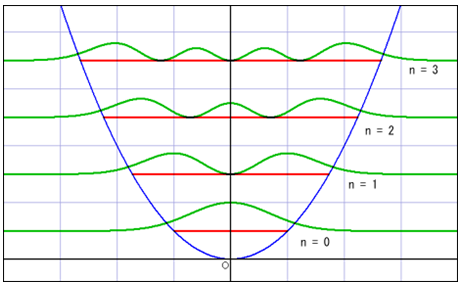
※The red line is the energy state(n). The probability density and n is changed at intervals.
☆The universe had particles that have exactly the same properties without limit, at energy following the mathematical rules!
○The universe was born from a quantum fluctuation.
○Wave function is a function of the complex because the wave equation contains complex number. [2]
・・・The universe is represented by imaginary!
17-2 Material Wave(de Broglie wave)
○On a submicroscopic level, there is no boundary strict between particles and wave.
→When existence is regarded as a wave motion, in physics, it is called a "place." For example, light is wave motion of an electric field and magnetic field.
※ It is under a very microscopic situation like an electron beam that the character as a wave is actually observed.
※ It is impossible to determine the size of the electron.
※ And the length of orbit around the nucleus is an integer multiple of the wavelength (10 minus 10 square m).
=Why the electrons are not getting stuck in the nucleus.
○The image of the wave of complex number [1]
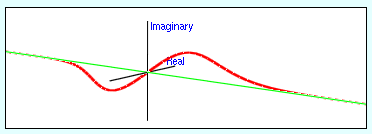
※Whole wave represents one of the particles.
※Height and depth of the wave corresponds to the size of the wave function.
:de Broglie wave=the wave function
○Material Wave:A wave that moves the space represented by the complex number. [3]:without direction(Scalar wave)
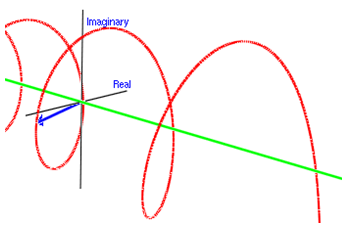
17-3 Applications [4]
・Description of the behaviors of the subatomic particles
・Computational chemistry
・The presence description of antimatter and negative energy
・Basic theory of semiconductor engineering → Electronic devices design
(the laser, the transistor (and thus the microchip), the electron microscope, and magnetic resonance imaging (MRI) , the light emitting diode, USB drives)
・Basic theory of superconductivity and superfluidity
・Quantum cryptography
・Quantum computing
・Quantum teleportation
・Parallel universes
○Unsolved problem
・Quantum gravity theory is incomplete.
17-4 Uncertainty Principle → No.18
【References】
1. 広江克彦”EMANの量子力学” Katsuhiko Hioe” EMAN’s Quantum mechanics”(Japanese)
http://eman-physics.net/quantum/contents.html
2.Lecture 3: The Wave Function - MIT OpenCourseWare
http://ocw.mit.edu/courses/physics/8-04-quantum-physics-i-spring-2013/lecture-notes/MIT8_04S13_Lec03.pdf
3. EMAMの物理学・量子力学/調和振動子 EMAN’s Physics ・Quantum mechanics/ harmonic oscillator (Japanese)
http://eman-physics.net/quantum/oscillator.html
4. Quantum mechanics - Wikipedia
18 Uncertainty Principle【What is the Universe?】Dialogue with the Universe
18-1 1927 Werner Heisenberg
Introduced first in 1927, by the German physicist Werner Heisenberg, it states that the more precisely the position of some particle is determined, the less precisely its momentum can be known, and vice versa.
You can answer only according to probability on the level of quantum.
○The formal inequality relating the standard deviation of position σx and the standard deviation of momentum σp
σxσp≧h
:No matter how improve the accuracy of the measurement, the product of the standard deviation of the position and momentum is greater than h.
:One is uncertain when you try to confirm the other.
・x:position、p:momentum
・h:Planck constant(6.626×10^-34 J・s)
: Particles are spread out within a certain range and exist on the level of quantum.
○In the case of energy and time
σEσt≧h
:Beating only a little law of conservation of energy, it may be borrowed energy.
※However it must return as fast as borrow a lot.
・E:energy、t: time
⇒Energy is possible to materialize.⇒Pairs of matter and anti-matter particles are constantly being created and annihilated.
=Quantum fluctuations
⇒Also in vacuum, pairs of matter and anti-matter particles are constantly being created and annihilated.: Vacuum fluctuations
⇒The vacuum has a vastly complex structure.
・Vacuum fluctuations causes a measurable force (Casimir effect) in infinitesimal.
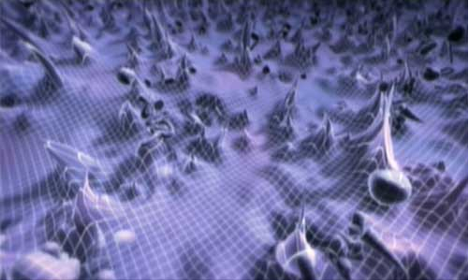
※Vacuum fluctuations [3]
18-2 Casimir effect
○The typical example is of the two uncharged conductive plates in a vacuum, placed a few nanometers apart. The Casimir effect produces the negative pressure. It is due to quantum vacuum fluctuations of the electromagnetic field.
○As the two mirrors move closer to each other, the longer waves will no longer fit--the result being that the total amount of energy in the vacuum between the plates will be a bit less than the amount elsewhere in the vacuum. Thus, the mirrors will attract each other, just as two objects held together by a stretched spring will move together as the energy stored in the spring decreases. [4]
○The dynamical Casimir effect is the production of particles and energy from an accelerated moving mirror. [5] Further, there may help development of quantum computers.
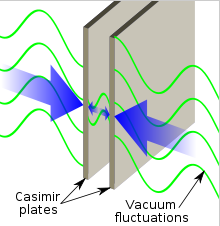
18-3 Phase Transitions of Vacuum /Inflation Cosmology/Quantum Tunneling
○Vacuum is to shift to more of the state of low energy:phase transition.
○In physical cosmology, cosmic inflation, cosmological inflation, or just inflation is a theory of exponential expansion of space in the early universe. The inflationary epoch lasted from 10 minus 36 square seconds until after 10 minus 34 square seconds.
(The size of the universe (10^-27m) is much smaller than atom (10^-10m).
⇒3 millimeters (10^-3m))
○The driving force behind this inflation has been said that the energy that was released during the phase transition of the vacuum.
○In early inflationary models, the phase transition of the vacuum was considered that it is generated by the Quantum tunnelling or tunnel effect. However, in a model named new inflation or slow-roll inflation, instead of tunneling out of a false vacuum state, inflation is considered that occurred by rolling down a potential energy hill.
※Quantum tunnelling or tunnel effect to the quantum mechanical phenomenon where a particle tunnels through a barrier that it classicallycould not surmount. In the quantum theory it is explained by the uncertainty principle.
It has important applications to modern devices such as the tunnel diode, quantum computing, and the scanning tunnelling microscope. [3]
※Nuclear fusion is also thanks to the tunnel effect. Without the tunnel effect protons can not collide with each other. And the sun can not shine. [6]
【Refereces】
1.Wikipedia: Uncertainty principle
2. ハイゼンベルクの不確定性原理 - nifty Uncertainty principle- nifty
http://homepage2.nifty.com/einstein/contents/relativity/contents/relativity3055.html
3.RevoScience”Young researcher proposes new explaination for unsolved problems in physics…”
http://revoscience.com/en/young-researcher-proposes-new-explaination-for-unsolved-problems-in-physics-and-revolutionizes-the-theory-of-quantum-fluctuations/
4. “What is the Casimir effect?”SCUENTIFIC AMERICAN 1998
http://www.scientificamerican.com/article/what-is-the-casimir-effec/
5. Wikipedia:Casimir effect
6. Masahiro Maeno “Introduction to Quantum mechanics(Japanese) " 20060216 (p.107)
http://www.phys.u-ryukyu.ac.jp/~maeno/qm/qm.pdf
0 件のコメント:
コメントを投稿